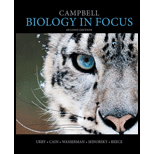
Concept explainers
Which of the following biomes is correctly paired with the description of its climate?
- A. savanna–low temperature, precipitation uniform during the year
- B. tundra–long summers, mild winters
- C. temperate broad leaf forest–relatively short growing season, mild winters
- D. tropical forests–nearly constant day length and temperature
Introduction:
A community of animals and plants with common characteristics for their environment is called a biome. It includes the likes of tropical forests, savannas, tundra and so on.
Answer to Problem 1TYU
Correct answer:
The tropical forests are near the equator, so their temperature is constantly warm and the day lengths are constant too. Therefore, option (D) is correct.
Explanation of Solution
Reason for the correct statement:
The region near the equator is always warm and the day length constant throughout the year as the sun moves almost perpendicular to the horizon all along the year.
Option (D) is given as “tropical forests-nearly constant day length and temperature”.
“Tropical forests-nearly constant day length and temperature is the biome which is correctly paired with the description of its climate”, it is the right answer.
Hence, option (D) is correct.
Reasons for the incorrect statements:
Option (A) is given as “savanna-low temperature, precipitation uniform during the year”.
Savannas are a mix of woodland and grassland ecosystems. They don’t have low temperatures and neither do they have uniform rain during the year. So, it is a wrong answer.
Option (B) is given as “tundra-long summers, mild winters”.
Tundra regions are very cold throughout the year and don’t have long summers. So, it is a wrong answer.
Option (C) is given as “temperate broadleaf forest-relatively short growing season, mild winters”.
Temperate broadleaf forests have cold winters. So, it is a wrong answer.
Hence, options (A), (B) and (C) are incorrect.
Tropical forests have constant temperature and day length throughout the year as they are near the equator.
Want to see more full solutions like this?
Chapter 40 Solutions
Campbell Biology in Focus (2nd Edition)
Additional Science Textbook Solutions
Microbiology Fundamentals: A Clinical Approach
Laboratory Manual For Human Anatomy & Physiology
SEELEY'S ANATOMY+PHYSIOLOGY
Genetics: From Genes to Genomes
Human Physiology: An Integrated Approach (8th Edition)
- Molecular Biology Explain why changing the codon GGG to GGA should not be harmful. Please help . Thank youarrow_forwardStage Percent Time in Hours Interphase .60 14.4 Prophase .20 4.8 Metaphase .10 2.4 Anaphase .06 1.44 Telophase .03 .72 Cytukinesis .01 .24 Can you summarize the results in the chart and explain which phases are faster and why the slower ones are slow?arrow_forwardCan you circle a cell in the different stages of mitosis? 1.prophase 2.metaphase 3.anaphase 4.telophase 5.cytokinesisarrow_forward
- Which microbe does not live part of its lifecycle outside humans? A. Toxoplasma gondii B. Cytomegalovirus C. Francisella tularensis D. Plasmodium falciparum explain your answer thoroughly.arrow_forwardSelect all of the following that the ablation (knockout) or ectopoic expression (gain of function) of Hox can contribute to. Another set of wings in the fruit fly, duplication of fingernails, ectopic ears in mice, excess feathers in duck/quail chimeras, and homeosis of segment 2 to jaw in Hox2a mutantsarrow_forwardSelect all of the following that changes in the MC1R gene can lead to: Changes in spots/stripes in lizards, changes in coat coloration in mice, ectopic ear formation in Siberian hamsters, and red hair in humansarrow_forward
- Pleiotropic genes are genes that (blank) Cause a swapping of organs/structures, are the result of duplicated sets of chromosomes, never produce protein products, and have more than one purpose/functionarrow_forwardA loss of function mutation in Pitx1 enhancers can cause (blank) Removal of Pitx1 exons and growth of ectopic hindlimbs, growth of extra ectopic forelimbs, loss of forelimb specification and development, and loss of hindlimb specification and developmentarrow_forwardHox1a most likely contributes to (blank) patterning in the developing embryo? Ventral, posterior, limb or anteriorarrow_forward
- Select all of the following that can help establish Hox gene expression boundaries (things that affect Hox and not things that Hox affects). Retinoic acid, anterior/posterior axis, fibroblast growth factors, vagal neural crest, and enhancersarrow_forwardEctopic expression of Hox often results in (blank) phenotypes. (Blank) transformations are characterized by the replacement of one body part/structure with another. Hoxeotic, homealoneotic, joexotic, or homeoticarrow_forwardWhat's the difference when drawing omega-6 and omega-3?arrow_forward
 Concepts of BiologyBiologyISBN:9781938168116Author:Samantha Fowler, Rebecca Roush, James WisePublisher:OpenStax College
Concepts of BiologyBiologyISBN:9781938168116Author:Samantha Fowler, Rebecca Roush, James WisePublisher:OpenStax College Biology (MindTap Course List)BiologyISBN:9781337392938Author:Eldra Solomon, Charles Martin, Diana W. Martin, Linda R. BergPublisher:Cengage Learning
Biology (MindTap Course List)BiologyISBN:9781337392938Author:Eldra Solomon, Charles Martin, Diana W. Martin, Linda R. BergPublisher:Cengage Learning
 Biology 2eBiologyISBN:9781947172517Author:Matthew Douglas, Jung Choi, Mary Ann ClarkPublisher:OpenStax
Biology 2eBiologyISBN:9781947172517Author:Matthew Douglas, Jung Choi, Mary Ann ClarkPublisher:OpenStax Human Biology (MindTap Course List)BiologyISBN:9781305112100Author:Cecie Starr, Beverly McMillanPublisher:Cengage Learning
Human Biology (MindTap Course List)BiologyISBN:9781305112100Author:Cecie Starr, Beverly McMillanPublisher:Cengage Learning Biology Today and Tomorrow without Physiology (Mi...BiologyISBN:9781305117396Author:Cecie Starr, Christine Evers, Lisa StarrPublisher:Cengage Learning
Biology Today and Tomorrow without Physiology (Mi...BiologyISBN:9781305117396Author:Cecie Starr, Christine Evers, Lisa StarrPublisher:Cengage Learning





